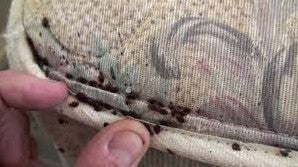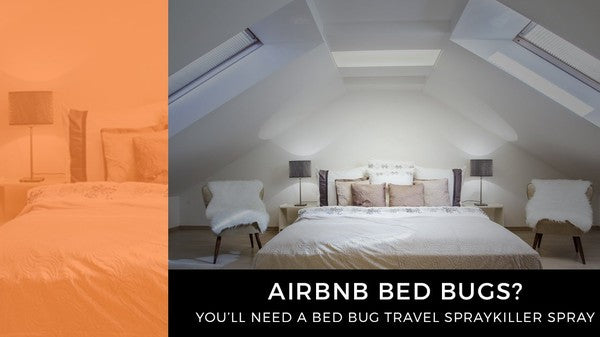Bed Bug Rash and Other Symptoms of an Infestation

Regardless of where they live or their level of hygiene, anyone can suffer the effects of a bed bug infestation. A common misconception regarding bed bugs is that these creatures only make homes among those who are dirty, unclean, or risky with their activities. These insects do not mind your social status, living conditions, or hygiene level. These are genuinely equal-opportunity parasites. Bed bugs require a haven to hide within your suitcase, clothing, boxes, purse, and even shoes. After hitching a ride on one of your belongings, it's only a matter of time before a few bugs proliferate into a nest filled with hundreds, if not thousands, of swift-moving, hard-to-kill pests.
Because these insects typically hide throughout the day and are masters in finding hard-to-reach areas within your bed, furniture, or room, many people are unaware an infestation is thriving until they begin to experience physical symptoms.
Unfortunately, the side effects of being feasted upon generally begin as small insect bites, typically attributed to mosquitoes, spiders, or other minor insects. While it may be challenging to identify the source of a mysterious bug bite, it's imperative to closely inspect each bite's size, proliferation, and location.

The Anatomy of a Bed Bug Bite – Identifying Its Symptoms
At the beginning of an infestation, it's not uncommon to misinterpret a bed bug bite as a flea, mosquito, or spider bite. However, unlike the aforementioned, bed bug bites increase in number and severity as the days progress. A single bed bug can produce multiple bites. Because of this, the primary symptom of a bite is a cluster of bites within a zigzag pattern. Bed bugs are most active at night. While you sleep, they emerge from their hiding places and feast. Unlike fleas and other insects, which primarily attack specific parts of your body, bed bugs attack any exposed area of flesh. Therefore, it's possible to experience bites on your torso, arms, neck, and legs. Bed bug bites often resemble hives, chickenpox, or an unexplained rash; physicians and sufferers frequently refer to the bites as bed bug rash.
Along with the notorious pattern of bites, its physical appearance indicates whether or not you're dealing with bed bugs. Bites typically form into raised welts, which are incredibly itchy. For many, the anesthetic properties within its saliva result in an allergic reaction. This reaction makes each bite itchy. Although bed bugs cannot introduce disease into their host, it's possible to experience skin infections by itching bites with bacteria-filled fingernails.
Since bed bugs are only active during the night—primarily an hour or so before sunrise—if you are awakened at night by an intense itching feeling, it's likely that these parasites are the source of your discomfort. After you've identified your bites, now comes the fun part—confirming your bites through a physical inspection of your surroundings.
Inspecting Your Home – Signs of a Bed Bug Infestation
Once you've identified your bites as similar to bed bugs, you must confirm your suspicion by physically verifying the presence of bed bugs. This is one of the most critical steps. The only way to eradicate bed bugs is to find out where they live. Getting rid of bed bugs in your home is the only way to stop the itching and discomfort caused by their bites.
If you have a severe infestation, you may see a collection of bugs; however, most individuals confirm the presence of bed bugs through evidence of their habitation. There are four signs you should look for when inspecting your bed and home:
Bed Bug Odor: Go outside and take several deep breaths to cleanse your nostrils. Immediately walk into your room and breathe deeply. If you find the room has a musty, sweet odor, this may be a sign of a heavy bed bug infestation. Bed bugs communicate by releasing unique chemicals, which produce a distinctive odor; however, not everyone will notice this smell.
Black Specks Along Your Bedding: Look closely at your mattress, box spring, and headboards for small blackish specks. Bed bugs produce black excrement, which may be seen as small balls of black material or stains along the creases of fabric.
Exoskeletons: Bed bugs shed their outer shells regularly, resulting in small shell-like remains in specific areas of your bed and home. These remains are typically found in mattress creases, headboards, and under couch cushions.
The Actual Bug: The easiest way to confirm a bed bug infestation is by viewing the bugs. While smaller infestations may make this a difficult process, medium-to-large infestations are relatively easy to locate. Bed bugs tend to stay close to their hosts. Therefore, look closely along mattress seams, bed frame joints, and under sofa cushions.
Our natural, plant-based Bed Bug Patrol Killer Spray provides an all-natural solution to infestations of bed bugs, as well as fleas, spiders, and other common indoor bugs. Our 100% natural solution is made in the USA. It relies on the power of natural ingredients like citric acid, clove oil, and peppermint oil to naturally deter these bugs from living in your furnishings and upholstery. Just spray our solution on affected surfaces twice per day, and it will get to work on exterminating your bed bugs and preventing their return. To keep you safe from bed bugs on your travels, arm yourself with our Bed Bug Blasting Travel Spray, which comes in a handy, TSA-approved travel-size bottle for your convenience.









